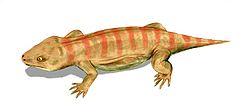副爬行动物
来自维基百科,自由的百科全书
副爬行动物(Parareptilia)是爬行动物的一个演化支或是亚纲,根据不同的定义,范围为已灭亡的原始无孔爬行动物,或是无孔亚纲的另一名称。这两个范围的效用,取决于龟鳖目在生物演化史上的地位,副爬行动物与其它爬行类的关系仍然未确定。
分类历史
Everett C. Olson在1947年建立起这名称,意为“接近爬行动物”,用来包含一群相对于真爬行动物的已灭绝古生代爬行类。
这名称后来废弃不用,直到它再度被亲缘分支分类法研究使用,用来包含与龟鳖目无关系的无孔亚纲。在1988年,嘉克斯·高斯特(Jacques Gauthier) 与其他人提出许多羊膜动物的第一个系统发生学定义,将蜥形纲(Sauropsida)定义为爬行纲(Reptilia)的母演化支,并提出无孔亚纲由杯龙目与龟鳖目两个姐妹分类单元构成(比阿尔弗雷德·罗默在1967年提出的定义还要狭窄)。如此一来,许多二叠纪与三叠纪爬行类不再包括于无孔亚纲内,因此需要建立一个名称来包含它们,所以副爬行动物被再度使用。然而,他们没有足够信心使副爬行动物可成为正式的分类。
以下为高斯特等人提出的演化树:
| 羊膜动物 |
| ||||||||||||||||||||||||||||||||||||||||||||||||
Michel Laurin与Robert Reisz在1995年提出一个不同的分类法,爬行纲被分成副爬行动物(现为正式的分类)与真爬行动物。大鼻龙科被改成真爬行动物,副爬行动物包括早期无孔亚纲与龟鳖目,但不包含大鼻龙科与Protorothyrididae科。中龙科被列在两群之外,成为爬行纲(但依旧是蜥形纲)的姐妹分类。传统的无孔亚纲被否决成并系群。如下列:
| 羊膜动物 |
| ||||||||||||||||||||||||||||||||||||||||||||||||
相反地,Oliver Rieppel于1994与1995年,并与de Braga于1996年与1997年,先后提出龟鳖目其实跟鳍龙超目有关系,所以是双孔亚纲。在1998年,Rafael Zardoya与Axel Meyer以分子系统发育学支持龟鳖目是双孔亚纲的理论。如果属实,副爬行动物将成为完全灭绝的演化支。然而当时这假说并不广为脊椎动物生物学家广泛接受,麦可·班顿(Michael Benton)在2000与2004年保留传统的无孔亚纲来包括副爬行动物与龟鳖目。
以下分支图是依照M.S. Lee于2013年的分析所绘制。[1]
| 羊膜动物 Amniota |
| ||||||||||||||||||||||||||||||||||||||||||||||||||||||||||||||||||||||||||||||||||||||||||||||||||||||||||||||||||||||||||||||
参见
参考资料
- Benton, M. J. Vertebrate Paleontology 2nd. London: Blackwell Science Ltd. 2000. ISBN 0-632-05614-2., 3rd ed. 2004 ISBN 978-0-632-05637-8
- deBraga, M.; Rieppel, O. Reptile phylogeny and the interrelationships of turtles. Zoological Journal of the Linnean Society. 1997, 120 (3): 281–354. doi:10.1006/zjls.1997.0079.
- deBraga, M.; Reisz, R. R. The Early Permian reptile Acleistorhinus pteroticus and its phylogenetic position. Journal of Vertebrate Paleontology. 1996, 16 (3): 384–395. doi:10.1080/02724634.1996.10011328.
- Gauthier, J.; A. G. Kluge, & T. Rowe. The early evolution of the Amniota. M. J. Benton (ed.) (编). The phylogeny and classification of the tetrapods, Volume 1: amphibians, reptiles, birds. 103-155. Oxford: Clarendon Press. 1988.
- Iwabe, N.; Hara, Y.; Kumazawa, Y.; Shibamoto, K.; Saito, Y.; Miyata, T.; Katoh, K. Sister group relationship of turtles to the bird-crocodilian clade revealed by nuclear DNA-coded proteins. Molecular Biology and Evolution. 2004-12-29, 22 (4): 810–813 [2010-12-31]. PMID 15625185. doi:10.1093/molbev/msi075. (原始内容存档于2016-04-12).
- Katsu, Y.; Guillette; Braun, E. L.; Guillette, L. J. Jr.; Iguchi, T. From reptilian phylogenomics to reptilian genomes: analyses of c-Jun and DJ-1 proto-oncogenes. Cytogenetic and Genome Research. 2010-03-17, 127 (2–4): 79–93. PMID 20234127. doi:10.1159/000297715. Authors list列表缺少
|last2=(帮助) - Laurin, M.; Gauthier, J. A. Phylogeny and Classification of Amniotes. at the Tree of Life Web Project. 1996 [2007-05-09]. (原始内容存档于2020-11-02).
- Laurin, M.; Reisz, R. R. A reevaluation of early amniote phylogeny. Zoological Journal of the Linnean Society. 1995, 113 (2): 165–223. doi:10.1111/j.1096-3642.1995.tb00932.x. (abstract (页面存档备份,存于互联网档案馆))
- Olson, E. C. The family Diadectidae and its bearing on the classification of reptiles. Fieldiana Geology. 1947, 11: 1–53. ISSN 0096-2651.
- Rieppel, O. Osteology of Simosaurus gaillardoti and the relationships of stem-group sauropterygia. Fieldiana Geology. 1994, 1462: 1–85. ISSN 0096-2651.
- Rieppel, O. Studies on skeleton formation in reptiles: implications for turtle relationships. Zoology-Analysis of Complex Systems. 1995, 98: 298–308.
- Rieppel, O.; deBraga, M. Turtles as diapsid reptiles. Nature. 1996, 384 (6608): 453–455. doi:10.1038/384453a0.
- Romer, A. S. Vertebrate Paleontology 3rd. Chicago: University of Chicago Press. 1967. ISBN 0-7167-1822-7.
- Roos, Jonas; Aggarwal, Ramesh K.; Janke, Axel. Extended mitogenomic phylogenetic analyses yield new insight into crocodylian evolution and their survival of the Cretaceous–Tertiary boundary. Molecular Phylogenetics and Evolution. Nov 2007, 45 (2): 663–673. PMID 17719245. doi:10.1016/j.ympev.2007.06.018.
- Zardoya, R.; Meyer, A. Complete mitochondrial genome suggests diapsid affinities of turtles. Proc Natl Acad Sci U S A. 1998, 95 (24): 14226–14231. ISSN 0027-8424. PMC 24355
 . PMID 9826682. doi:10.1073/pnas.95.24.14226.
. PMID 9826682. doi:10.1073/pnas.95.24.14226.
外部链接
Wikiwand - on
Seamless Wikipedia browsing. On steroids.






